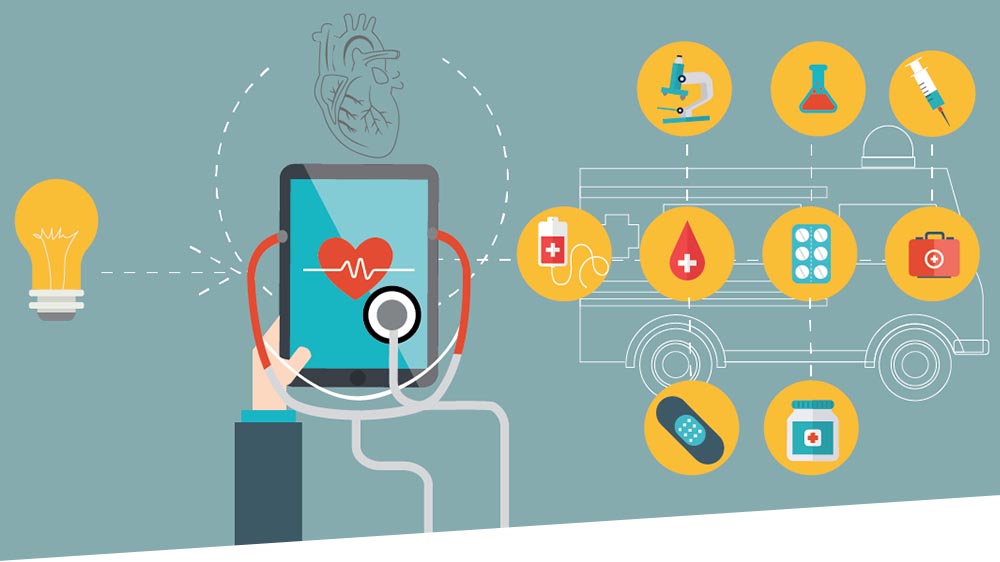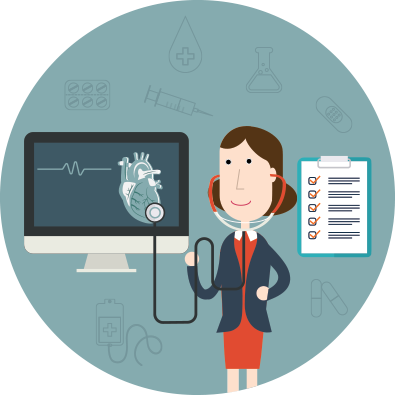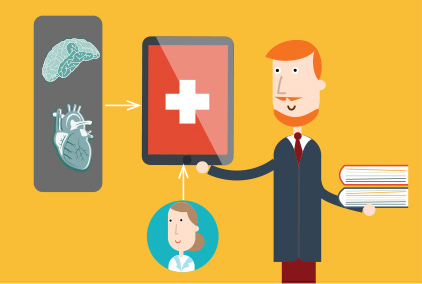
15 Mar eLearning in the Healthcare Industry
eLearning has obvious advantages for large organisations that need to continually update their workforce’s skills. It’s a scalable and relatively inexpensive form of training; it allows for asynchronous learning, and advances in mobile learning has made it more accessible than ever before. These benefits are all relevant to hospitals and healthcare institutions, which must work around tight budgets and long staff hours to provide critical professional development courses.
Education is central to the healthcare industry, and learning design for this area must take its specific needs into account. Most healthcare professionals are trained to apply the principles of evidence-based practice; according to Sackett et al. (1996), this is “the conscientious, explicit and judicious use of current best evidence in making decisions about the care of the individual patient. It means integrating individual clinical expertise with the best available external clinical evidence from systematic research.” Healthcare professionals must spend their career honing these skills in decision-making, analysis, evaluation and communication.
The allied health professions have always been quick to adapt to the latest research and innovation, and Continuous Professional Development (CPD) has long been a key part of the job. However, the structure of the healthcare industry worldwide is undergoing a profound change. Hospitals are reacting to rapid changes in technology, which offer not just medical innovation, but also increased efficiency. Healthcare institutions are finding new ways to collaborate with insurance and pharmaceutical companies to develop accessible and affordable plans for care. The industry is moving towards value-based care to get more from services. Preventative medicine is an increasingly important strategy in health management. Patients are becoming more aware and more involved in their own health management, and this is increasing the demand for mobile and online information. PwC’s survey of top health industry trends underlines these coming changes: from the report, it’s striking how critical the role of online educational materials and training courses will become. From augmented reality games about nutrition, to educating young doctors about structural change in the health system; integrating technology introduced by new partnerships; providing strong educational resources to manage infectious diseases; or collecting data from patients themselves, and using their input to contribute to research, it’s clear that eLearning has huge potential for medicine.
There’s no doubt that eLearning is effective in clinical education. A recent study has confirmed that students in the health professions acquire knowledge and skills through eLearning “as well as or better than they do through traditional teaching.” However, the study also shows that there are certain barriers to eLearning which must be tackled for courses to be effective. How do you go about designing effective courses for the healthcare industry?
Plan for Effective Delivery
 The first step in preparing your course is to think about how it’s going to be delivered, and whether your learners are really going to learn in the way that you expect. The WHO report on eLearning for Undergraduate Health Professional Education identifies several Critical Success Factors which determine the effectiveness of eLearning, including:
The first step in preparing your course is to think about how it’s going to be delivered, and whether your learners are really going to learn in the way that you expect. The WHO report on eLearning for Undergraduate Health Professional Education identifies several Critical Success Factors which determine the effectiveness of eLearning, including:
• its organisational setting;
• the technological infrastructure;
• and the instructional systems and curriculum design.
Will your learners have sufficient IT skills and technical support to succeed? eLearning can reduce the pressure for teaching staff, but it could increase the workload for eLearning curriculum developers; and of course, there’s the potential that over-stretched hospital staff will end up doing their coursework outside of work hours, and eLearning will become an addition to the burden. The report also points out that “each stakeholder brings forward a variety of motivations pertaining to the benefits and risks of an intervention – such as economic, technological, or pedagogical legitimacy” (56), and that this influence can determine whether the course is well-received. You’ll need to plan carefully around each of these factors for a successful course.
Design for Healthcare as a System
You may be designing a very specific course in a specialised area, but it’s a good idea to keep in mind that the healthcare industry is a highly interdependent system. In this excellent interview on eLearning and health financing, Senior Health Financing Specialist Matthew Jowett points out that this kind of broad perspective is easily forgotten:
“…we go to great lengths to position our thinking on health financing within the broader health system. We frame it very carefully. If you look at the first module of the e-learning course, it’s not really about health financing—it’s about universal health coverage. It comes to health financing and considers: How does health financing contribute, together with other elements of the health system, to making progress toward UHC? That’s the real question.”
For Jowett, the best way to make these connections with eLearning is to design courses that are flexible and adaptable. Jowett sees his course developing in four different ways: as a standard distance learning course; as an introductory module to be completed before face-to-face training; as a refresher module after a training course; or as one element in “a structured blended learning and capacity building program.” If an eLearning course is to be used in all these different ways, then it must be relevant to each of these different contexts. The key for Jowett is to be “creative” in thinking about how technical assistance is delivered; in the health industry, eLearning needs to be more valuable than a simple, static course.
Get the Most from Interactive Media
Interactive media has huge educational potential in healthcare training. So many diagnoses now depend on scans, and online learning can make use these images and diagrams in ways that a static textbook can’t. A textbook quiz is quickly mastered, but online learning environments can vary the content and test examples to keep giving a new challenge. An interactive eLearning course can prompt students to use higher-order thinking skills in analysing, distinguishing, categorising, comparing and interpreting information; passive reading could never offer these inbuilt challenges. Video-based simulations are also perfect for medical education: scenarios are immersive and affective, and the learner’s emotions are immediately engaged as their real-world experience is tested.
As augmented and virtual reality technologies develop, they will quickly come to have a huge influence in healthcare education. Their great strength is that they allow doctors and nurses to make mistakes in a realistic, low-risk environment. It’s worth keeping up-to-date with these developments—this article from The Medical Futurist gives some great examples of the potentials of AR and VR for both doctors and patients.
Get Patients Involved
 eLearning isn’t just for training and developing clinician’s skills. A whole new field of digital medicine is beginning to influence healthcare practice, and eLearning will have an important role in public awareness campaigns and online health initiatives. Medical research has always recognised the importance of studying community health; with the introduction of digital health initiatives, the community is set to expand. The EU has already funded some online public health programmes, such as IROHLA, a project that advances health literacy in older people in Europe. A good overview is provided in this article from efrontlearning.com, which also points out that eLearning and online materials can be extremely helpful as a source of information “in situations where patients are reluctant to seek professional treatment directly, such as cases of depression, gambling addiction, anorexia, mental health problems, etc.” eLearning courses could also be of great use in pharmacy, as patients often need training in how to take medicine or manage their symptoms. These online courses could be vital for pharmaceutical researchers who need to collect information directly from patients about their health.
eLearning isn’t just for training and developing clinician’s skills. A whole new field of digital medicine is beginning to influence healthcare practice, and eLearning will have an important role in public awareness campaigns and online health initiatives. Medical research has always recognised the importance of studying community health; with the introduction of digital health initiatives, the community is set to expand. The EU has already funded some online public health programmes, such as IROHLA, a project that advances health literacy in older people in Europe. A good overview is provided in this article from efrontlearning.com, which also points out that eLearning and online materials can be extremely helpful as a source of information “in situations where patients are reluctant to seek professional treatment directly, such as cases of depression, gambling addiction, anorexia, mental health problems, etc.” eLearning courses could also be of great use in pharmacy, as patients often need training in how to take medicine or manage their symptoms. These online courses could be vital for pharmaceutical researchers who need to collect information directly from patients about their health.
Similarly, wearable tech will provide huge opportunities for clinicians and researchers to gather evidence using massive samples of data. This article from Raconteur.net includes an interview with Roman Chernyshev, senior vice president of healthcare and life sciences at global technology consulting firm DataArt, who explains that “it is a matter of time before medical devices collect continuously vital data from millions of patients around the world in real time and simultaneously compare them. These developments will change how diseases are diagnosed. Medical conditions will be predicted as a result of data and constant monitoring of health information.” At their best, personal monitoring devices can change the lives of patients who need to manage chronic conditions such as diabetes and COPD; at their worst, they can cause healthy people to worry about irrelevant fluctuations in their body. Doctors need to stay ahead of this demand for wearable technology to influence how it’s designed and used.
It’s clear that eHealth in all its forms is growing. A recent EU survey has shown that Europeans are comfortable using online health information, with six out of ten of Europeans going online when looking for health information, while 90% of those said that “the Internet helped them to improve their knowledge about health-related topics.” The goal for healthcare practitioners is to ensure that patients have access to reliable information online, as one part of a comprehensive healthcare strategy.
Resources:
• Andriotis, N. (2015, February 04). E-learning in the Healthcare Industry. Retrieved February 16, 2017, from https://www.efrontlearning.com/blog/2014/12/e-learning-healthcare-industry.html
• Augmented Reality In Healthcare Will Be Revolutionary. (2016, August 15). Retrieved February 16, 2017, from http://medicalfuturist.com/augmented-reality-in-healthcare-will-be-revolutionary/
• E Learning as good as traditional training for health professionals: where is the evidence? (2015). Retrieved January 20, 2017, from http://www.who.int/hrh/news/2015/e_learning_4_hrh/en/
• Europeans becoming enthusiastic users of online health information. (2014, November 28). Retrieved February 16, 2017, from https://ec.europa.eu/digital-single-market/en/news/europeans-becoming-enthusiastic-users-online-health-information
• Ferng, M. (2016, May 11). E-Learning Course on Health Financing Policy for Universal Health Coverage (UHC) – An Interview with Matthew Jowett. Retrieved February 16, 2017, from http://www.healthfinancingafrica.org/home/e-learning-course-on-health-financing-policy-for-universal-health-coverage-uhc-an-interview-with-matthew-jowett
• Lambert, V. (2016, October 18). Empowering patients to track their health through wearable tech. Retrieved February 16, 2017, from http://www.raconteur.net/healthcare/empowering-patients-to-track-their-health-through-wearable-tech
• PwC Health Research Institute. (2016, December). Top health industry issues of 2017: A year of uncertainty and opportunity (Publication). Retrieved February 16, 2017, from PwC Health Research Institute website: http://pwchealth.com/cgi-local/hregister.cgi/reg/pwc-hri-top-healthcare-issues-2017.pdf
• Sackett, D. L., Rosenberg, W. M., Muir Gray, J. A., Haynes, R. B., & Richardson, W. S. (1996). Evidence based medicine: what it is and what it isn’t. The BMJ, 312(71). doi:https://doi.org/10.1136/bmj.312.7023.71
• World Health Organisation & Imperial College London, (2015). eLearning for undergraduate health professional education – a systematic review informing a radical transformation of health workforce development (Rep.). Retrieved February 16, 2017. doi:http://whoeducationguidelines.org/sites/default/files/uploads/eLearning-healthprof-report.pdf
Subscribe to our Newsletter


